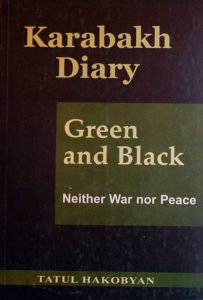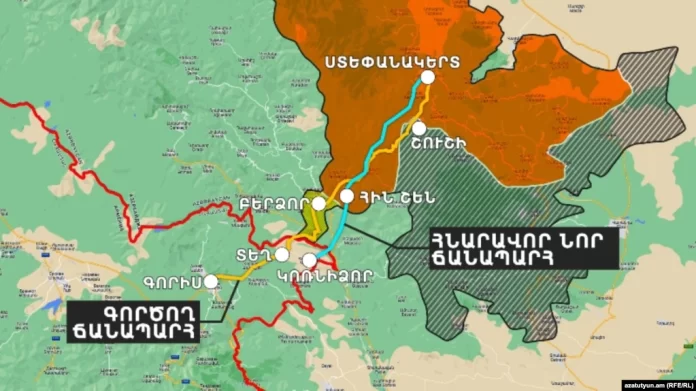Rahim Ghaziyev, the Defense Minister of Azerbaijan, was in Moscow on the morning of May 10, 1992. Pavel Grachov had just been appointed Defense Minister of Russia.
“I swear to Allah that I knelt down and started begging him, ‘Pasha, we do not want to fight against the Russians. We do not have the equipment. Sell us arms.’ After a long conversation he telephoned Army General, Nicolay Popov. I returned to Ganja. The military equipment was being sent to the Zangelan station. The equipment reached the section between Ghubatlu and Lachin and, for reasons unknown to me, Safar Abiyev, the deputy chief of staff, abandoned the equipment and troops and left Lachin. That was on May 11. At the time, we still controlled Turshsu and Lachin. Bloody battles were taking place, but the supporters of Abulfaz Elchibey, Heydar Aliyev and Ayaz Mutalibov were continuing to hold rallies in Baku; fighting for power.”
After the events in Shushi, the internal political tensions had reached their peak. On May 14, during the extraordinary session of Azerbaijan’s Supreme Council, Mutalibov announced that they had lost Khojalu and Shushi because of political errors and if Baku had not been in a confrontation with Moscow on military issues, Shushi would not have been captured. On the same day, he was reinstated as Azerbaijan’s President; this lasted for one day. The National Front considered Mutalibov’s return a coup d’état and began calling for civil disobedience. During a TV appearance Heydar Aliyev assessed Mutalibov’s restoration as a “military-state revolt”. On May 15, Mutalibov was once again, for the last time, removed from power. He was flown to Moscow in a Russian military helicopter. He still lives there.
On May 16, the situation in Azerbaijan was under the control of the Popular Front. The Supreme Council accepted Yaghub Mamedov’s resignation. On May 18, Isa Gambar, a 35 year-old historian/orientalist and one of the founders of the Popular Front, assumed the powers of the head of state pending presidential elections, thus becoming the youngest leader on post Soviet territory.
While a revolution was taking place in Azerbaijan, the NK forces were liberating the Armenian villages in the Berdadzor region of Shushi. On May 18, Lachin was seized and a land corridor was opened between Armenia and NK. The last Azerbaijani soldiers left Lachin on May 16. According to Ghaziev, there were 7 Grad units stationed in Lachin and a large quantity of munitions, but no shots were directed at the advancing Armenian force. There were no battles in Lachin.
Samvel Babayan insists that no operation for Lachin had been planned. “After Shushi the Azerbaijanis were in a state of panic. When we entered Berdadzor the enemy resisted for only one day. They were trying to hold down the heights, so that the population could get out. Lachin was simply the consequence of the success we had in Shushi and Lisagor.”
The capture of Lachin removed the 7 kilometer long corridor separating Armenia and NK. In its place a new, humanitarian corridor was formed. After several years of blockade, NK had a chance to breathe freely. However, the war was not over with Lachin; it entered a new phase. When NK forces seized Lachin, the reaction of the international community was not as harsh in contrast to its reaction when Kelbajar and other regions outside NKAO were seized. The UN Security Council did not pass any resolutions condemning the move.
“The international community was, to some extent, shocked by the occupation of Lachin. Azerbaijan did not yet know what to do. Certainly our diplomatic efforts had contributed to highlighting the blockade and aggression against NK. But overall I would ascribe it to the confusion in the international community rather than their thorough understanding of or care for NK,” said Gerard Libaridyan.
Vahan Papazyan explains it thusly, “It was explained to the international community that, without Lachin, there was a serious risk to the security of the people of NK. But it was not just that. The conflict was new and the international community had not yet become seriously involved in the issue. The Minsk group was just being formed. Later, the issue of Lachin was always separated from the rest of the territories; it was always understood that the region, the corridor were special.”
At the end of May 1992, Levon Ter-Petrosyan, who was in Egypt, said that the corridor to Armenia through Azerbaijan’s territory envisaged remedying the fact that the people of NK were suffering from lack of food and drugs. “Neither Armenia nor the NK intend to occupy more land than that necessary for a link between the republics.”5
Red Kurdistan
American journalist, Thomas Goltz, on visiting Lachin and Kelbajar in 1992, wrote, “Strangely, everyone there spoke Kurdish, not Azeri.”
It should not have been a surprise, as Lachin and Kelbajar had been populated for 200 years by Muslims Kurds, who bear no linguistic, genealogical or anthropological similarity to the Caucasian Tatars (present-day Azerbaijanis).
In mid 10th century a Kurdish dynasty ruled the territories between the Kur and Araks rivers. It had administrative centers in the cities of Dvin (several miles away from Yerevan) and Gandzak (present-day Gyanja in Azerbaijan). Later a branch of this dynasty settled in the city of Ani (capital of the Armenian Bagratid kingdom). In 1064, a few years after the collapse of the Bagratid kingdom, the Seljuk Turks occupied Ani and sold the city to the Shadadyan dynasty.
The question as to when Kurds settled in territories adjacent to present-day NK remains debatable. It is assumed that they came here in the 16th -17th centuries. Until the Kurdification and subsequent Azerification of Kelbajar (Karvatchar), Lachin (Berdzor) and surrounding regions – from the Mrav mountain range to the Araks River – had been inhabited predominantly by Armenians for many centuries.
In July 1923, Soviet Azerbaijan created Red Kurdistan, comprising the regions of Kelbajar, Lachin and Ghubatlu. Lachin (Abdallar) became the center of the province. In 1929 the province of Red Kurdistan was eliminated. Instead of provinces, new administrative units (‘okrugs’ or regions) were created in Azerbaijan. In May 1930, the Kurdistan Okrug was created, which was larger than the Kurdistan province and, together with Zangelan and a part of Jebrayil, had a border with Iran. Lachin remained the administrative center of the okrug. In July 1930, the okrugs were eliminated as administrative units in the Soviet Union and new administrative units were created; regions. The Kurdistan Okrug was eliminated a few months after its establishment but a region named Kurdistan was not created. Kurds inhabited Kelbajar and Lachin, lands separating Soviet Armenia and NK, and continued to be Kurdish-speaking for decades.
By creating the province of Kurdistan, Soviet strategists were probably trying to decrease the tension between Azerbaijan and Armenia. In 1918, there was dispute between Armenia and Azerbaijan over those regions where Red Kurdistan was later created. In other words, the Kurdish administrative territorial unit lay between NK and Armenia and not Azerbaijan itself. In addition, Moscow drew the borders in such a way that the two Armenian entities were artificially separated from each other. Consequently, to get from Armenia to the NKAO one had to pass through a seven kilometer stretch of land recently granted to Azerbaijan. In the mid-1920’s, the Soviets drew the borders of the newly created NKAO, leaving a 7 kilometer wide artificial buffer separating it from Armenia. Before that, Soviet Armenia and NK were separated by the Hakari (Hagaru) River; thus Kurdistan was also divided in two. Soviet maps show that, on the one hand, the regions of Goris and Shushi and on the other, the two parts of Kurdistan, had been arbitrarily separated; the line of separation being the Hakari River. In maps printed after 1928, a corridor of a few kilometers can be seen between Armenia and NK.
According to the 1926 census, the population in the province of Kurdistan was about 51,000, of which 37,000 were Kurds, 13,500 were Tatars (Azeris) and only 250 were Armenians. Up to 1918, three large Armenian villages – Hak, Alghuli and Harar – remained in the province of Kurdistan to come. The number of Armenians in Hak (Minkend) exceeded 800. As a result of the 1918 Armenian-Kurdish clashes, the Armenians were displaced from Hak. More than a thousand Armenians lived in Alghuli, but they were also displaced and went to live in different villages in NK and Goris (the closest city in Armenia to NK). In 1918, the number of Armenians in Harar (Ashagy Farajan) was about 1,100, while in 1921 there were only 50 Armenians left in the village.
After the elimination of Red Kurdistan, the assimilation of the Kurds began. This was facilitated by two main factors. First, was their shared faith – the Turkic speaking Azerbaijanis and the Kurds of Iranian origin are Muslim. Second, were Baku’s policies. If, in 1926, more than 37,000 Kurds lived in Red Kurdistan then, according to the last Soviet census in 1989, the number of Kurds in Azerbaijan was about 12,000. In 1992, the number of Kurds in Lachin and Kelbajar alone reached the tens of thousand, but they were considered Azerbaijani, though they continued to preserve their Kurdish identity and communicated with one another in their mother tongue.
This part is from Tatul Hakobyan‘s book – KARABAKH DIARY; GREEN and BLACK














